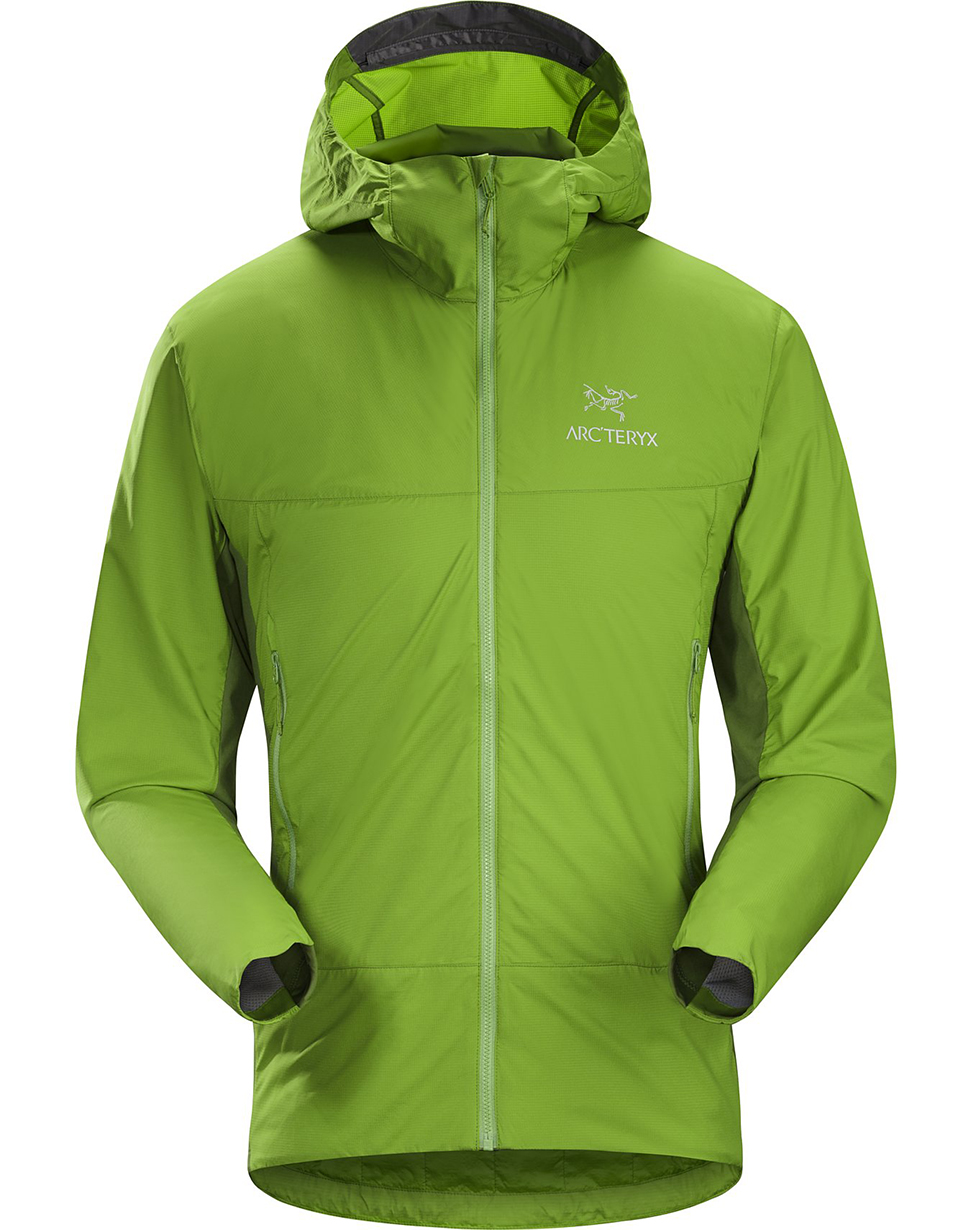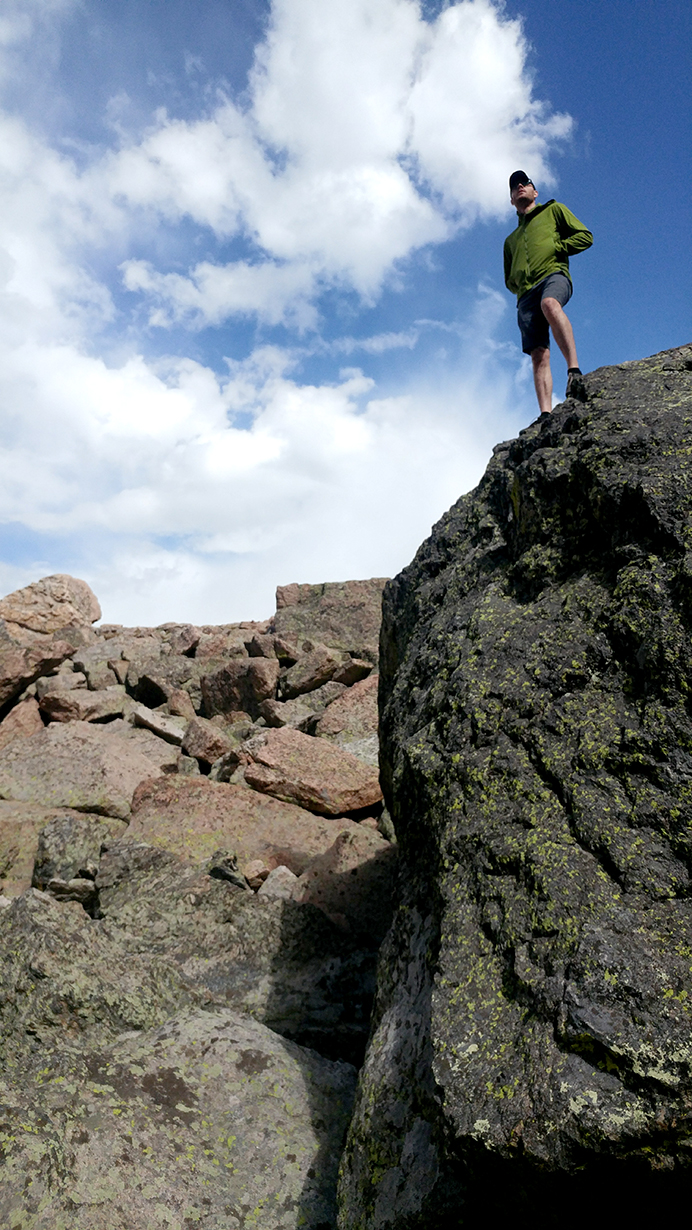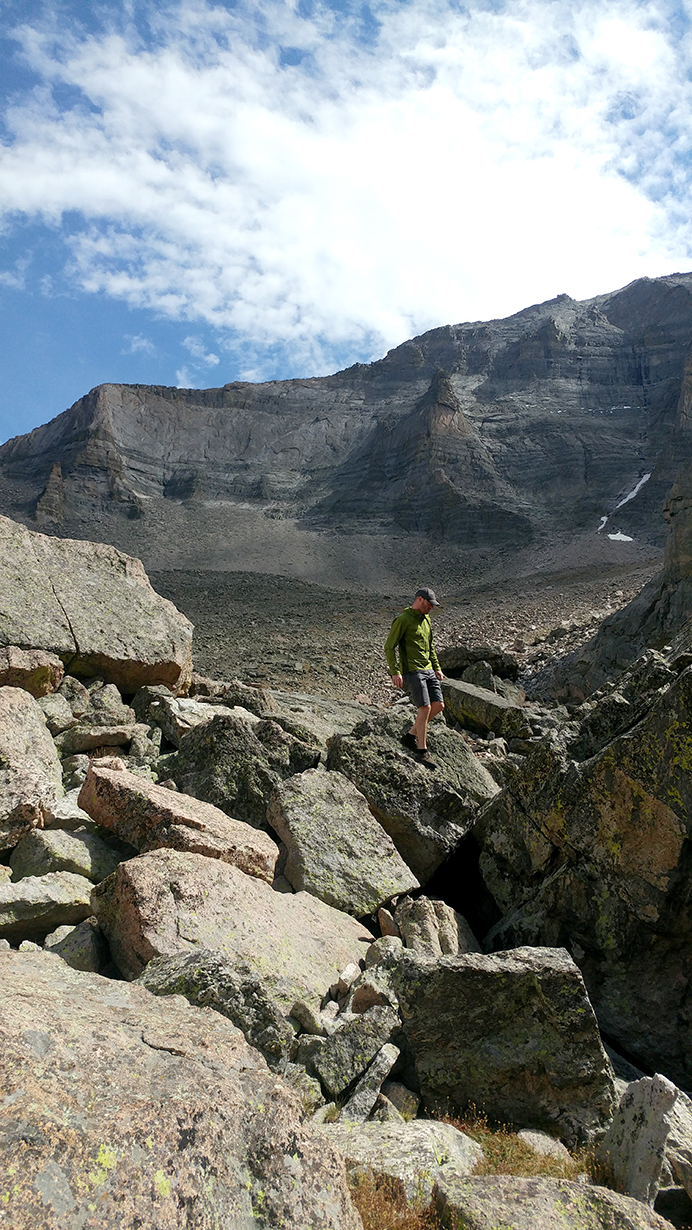
Arc’teryx Atom SL Hoody
Size Tested: Large
Blister’s Measured Weight: 272 g
Materials:
- Face Fabric: Tyono™ (20-denier Nylon)
- Side Panels: Torrent™ Fleece (84% Polyester / 16% Elastane)
- Insulation: 40-g Coreloft Compact™
- Sleeve Lining: Polyester Mesh
Stated Features:
- Arc’teryx Nu water repellent treatment
- Gusseted underarms for mobility and comfort
- Trim, slim fit, increases breathability during high output
- Adjustable, low profile uninsulated StormHood™
- No Slip Zip™ front zipper with chin guard and wind flap
- Shaped cuff with stretch fleece
- Drop back hem with adjustable hem drawcord
Pockets:
- 2 zippered hand pockets
MSRP: $229
Test Locations: Rocky Mountain National Park, Lumpy Ridge, & South Platte, CO; Moab & Zion National Park, UT; Vedauwoo, WY
Days tested: 14
Intro
Arc’teryx bills the Atom SL Hoody as insulation for milder conditions: a nice hike that turns on you when clouds move in, or something to bring on a chilly, pre-dawn approach. The Atom SL is a trimmed-down version of Arc’teryx’s Atom LT Hoody, which we loved as a mid layer for general use.
However, climbing — and particularly those days in the alpine — brings unique demands for outerwear choices, and the more minimal version of the Atom seemed like it might suit that environment better. So, I took the Atom SL to the local crags in Golden, into the alpine, and up a big wall in Zion to see how well it suited the vertical world relative to its beefier relative, as well as some of my other favorite climbing-friendly mid layers.
Fit
The “Trim” fit of the Atom SL is in line with what you would expect from much of Arc’teryx’s climbing apparel: slim and athletic. I’m 6’3”, and the bottom of the Large Atom SL comes down just below my hips, and I’ve got plenty of coverage from the sleeves.
Materials
If you’ve used the Atom LT (or read Lexi’s review) you’ll find the construction of the SL familiar: a lightweight 20-denier fabric with a DWR coating covers most of the jacket. A stripe of stretchy fabric (Arc’teryx’s proprietary polyester / elastane blend called “Torrent”) runs up the sides of the jacket and down the inside of the sleeves. In terms of insulation, the Atom SL uses Coreloft Compact 40 (as compared to the slightly beefier Coreloft 60 found in the Atom LT).
(note: denier is a unit of measure that describes the weight of a given textile fiber, specifically the weight in grams of 9,000 m of a single strand of that fiber. Silk is used as the natural reference and is 1-denier: 9,000m of silk weighs approximately 1 gram.)
Features
The list of features on the Atom SL is short, just what you want from an alpine garment. The mesh inside the sleeves is comfortable against skin even when you start sweating, so the jacket doesn’t ever feel sticky or tacky. The two front pockets have large enough openings that getting my hands in and out is easy, but the pocket also extends below the bottom of the zipper so smaller items aren’t at constant risk of falling out if you forget to zip it closed (I’m a huge fan of small-item loss-prevention tactics like this).
Weight and Packability
Along with packability, weight is a core concern when picking layers for climbing. With a stated weight of 260 g for a medium (my large weighed 272 g), the Atom SL is lighter than most other lightweight, synthetic mid layers. For the sake of comparison, the Arc’teryx Atom LT Hoody, Black Diamond Access Hoody, and Patagonia Nano Air Light Hoody come with stated weights of 360 g, 330 g, and 309 g, respectively. In terms of packed size, the size Large Atom SL packs down to about the size of a large grapefruit.
Insulation, Warmth, and Comparisons
As a minimalist mid layer above all else, the Atom SL is on the lighter side of cold weather protection, both in terms of weight and insulation, yet still manages to provide a considerable amount of warmth given its weight and packability. In terms of overall warmth, the Atom SL is roughly comparable to the Patagonia Nano-Air Light Hoody (which uses Patagonia’s 40-g FullRange insulation), and Black Diamond’s Access Hoody (which uses 60-g Primaloft Gold). Black Diamond’s First Light Hoody and Patagonia’s Regular Nano-Air Hoody offer more warmth than the Atom SL, but for considerably more weight and bulk.

Mid layers featuring 800-fill down offer better warmth-to-weight ratios, but don’t provide the same protection against weather as the synthetic fill found in the jackets mentioned above. Among synthetics, Patagonia’s excellent Micro Puff Hoody is in the same weight class as the Atom SL and offers much more warmth. However, the Micro Puff Hoody is designed with a very different purpose in mind — it’s meant to provide maximum warmth for minimal weight, with less attention paid to durability, breathability, and comfort. Meanwhile, the Atom SL is designed for a different environment altogether, which takes us to the next section…
Climbing / General Performance
If the the Atom SL isn’t the warmest option available to you, what does it offer vs. other mid layers? After a couple months of serious use, I think the answer to this question lies beyond the spec sheet. In reductionist terms, the Atom SL can be thought of as a windbreaker with some insulation around the torso. However, when viewed through the climbing lens, the Atom SL is better than that.
First and foremost, the Atom SL breathes really well, better than both the Nano Air Light or Access Hoody. This is great for hiking in chilly, pre-dawn weather since it allows you to not bother taking it on and off at each stop / start, but it’s even better for climbing where donning and shedding layers between belaying and climbing is significantly more cumbersome and involved than when on the trail.

This only really works, however, if a garment climbs well, which the Atom SL does. The stretchy “fleece” material on the sides and sleeves makes all the difference here in terms of providing mobility, and the gusseted underarms help keep the jacket beneath your harness when you’re reaching around. In fact, I found the Atom SL to be head and shoulders above any other lightweight insulator I’ve used as far as freedom of movement is concerned.
In terms of weather protection, the DWR on the Atom SL is effective, but not profoundly so — you’ll get wet if you get caught in heavy rain. Hopefully you’ll be able to buy enough time to get back to the shelter, but the Atom SL is definitely more windbreaker than rain shell as far as waterproofing is concerned.
The hood is uninsulated, keeping weight and bulk down while still offering some warmth and wind resistance under a helmet. The sleeves are also uninsulated, save for the mesh lining, and are thin and stay out of the way, making you feel like you’re wearing a low-profile base layer rather than a puffy mid layer. The insulation around your core keeps the warmth where you need it, but more importantly maintains good packability despite the synthetic fill (as opposed to more compressible down options). This is another perk of the Atom SL that gains greater significance in the climbing realm — packability is nice in general, but it’s essential on the wall.
Durability
The durability of the Atom SL is dictated by the 20-denier outer fabric. In my experience, the fabric on the Atom SL is durable enough to be stuffed in a pack somewhat carelessly, but not burly enough to be between your skin and the rock on a physical pitch. After wearing the Atom SL for a handful of crack pitches, there is some fraying at the ends of the sleeves from having to search for jams deeper inside a crack.
Ultimately, there is an essential trade-off between lightweight minimalism and durability, and wearing a piece on a physical climb is about as hard as one can be on apparel. On this spectrum, the Atom SL is durable enough that you don’t have to baby it in your pack or on the trail, but if durability on the rock is a priority for you, check out the Brooks Range Mountaineering Alpha Softshell. The Alpha Softshell is much more jacket (heavier and less packable, but much warmer) than the Atom SL, but the beefier sleeves tolerate a lot more of the abuse common on a long rock climb.
Who’s it For?
The Atom SL is one of the best pieces I’ve used for adding a little warmth to your kit without being much of a burden in terms of weight and packed size. If you’re in need of more serious warmth and need something that will take abuse, check out the Brooks Range Alpha Softshell. If you want to stick to super light and packable options but need to protect against colder temps (say, the sun just set on a January day, temps went from nice to frigid, and you’re still on the top pitch), check out the Montbell Plasma 1000 Down Jacket or Patagonia Micro Puff Hoody. Both of those layers are much better insulators that are great to have at a belay, but aren’t ideal on-route due to their even-lighter-weight fabrics and reduced breathability (due in part to their additional insulation).
The Atom SL strikes a balance between these factors: its materials are durable enough for most activities (apart from really physical climbs), while being lightweight and breathable enough to be used on an approach or even a trail run. The ideal setting for the Atom SL is an alpine trip (hiking, climbing, or scrambling) where you need a little warmth and weather protection without wanting to upsize your pack to accommodate your jacket. The Atom SL is equally at home hiking or climbing (just keep it away from cracks) on cool mornings or fall/winter/spring days that stretch into the evening.
Bottom Line
Taken as a whole, all the qualities mentioned above make the Arc’teryx Atom SL Hoody one of the best mid layers I’ve used for climbing. The mobility and packability are top-notch, and while it isn’t the warmest layer on the market, pairing the Atom SL with a good base layer covers most cool-weather rock climbing situations in which a fast-and-light mentality has some relevance (or you just don’t want to lug excess stuff to your local crag). Ultimately, this is a spring/fall/winter garment with alpine tactics in mind: fast, light, and versatile.
The Atom SL is also a great choice for summer alpine objectives, but I think it offers a lot of value on sunny fall, winter, and spring days that typically start and end with colder temperatures. I hate climbing with a pack if I can avoid it, and the Atom SL fits nicely into a light layering system that is breathable and low-profile enough to be worn during strenuous exercise if needed, giving you a lot of flexibility. If you want a mid layer to bring to the crag and on your alpine objectives without having to dedicate inordinate pack space to it, the Atom SL hits all the bases without any superfluous features, making it a great option for the alpine.

Maybe I missed it somewhere, but does this layer pack into it’s own stuff pocket? Kind of a necessity if you ask me for a climbing layer.
It doesn’t have a stuff pocket, and I can understand how that might be a deal-breaker. I’m a little more agnostic on them; especially for a layer such as this. For a proper belay jacket, I’m much more interested in the stuff-pocket because you want the layer so soon as you’re done leading the pitch, rather than having it in the pack your partner is carrying below you.
With a thin layer such as this, I typically either keep it in the pack for most of the day, breaking it out for a pre-dawn approach or wearing it climbing/descending once the sun goes down (think Levitation 29 in Red Rocks where you definitely want to get on that route in the winter, but the approach is still long and the days are short, so you’re in the dark for at least some of the time on either side). If I felt like I needed it during the day and we were trying to go without a pack, I would just stuff it into my approach shoes which are typically clipped to my haul loop. A tight fit with the large, but workable. A personal preference issue, but still a good piece of feedback for future generations of the jacket. I’ll pass it along to Arc’Teryx!
How, in practice, does this really compare to the Patagonia nano-air light hoody? Is one better than another for hiking, etc.?
Hi !
I’m beginner in this world and i’m looking for a Atom jacket because i Will make a trip in Chili/Bolivia in November. But i can’t make ou choice between Atom SL and LT… We gonna hiking and climbing à little bit, but it’s not our main activity. What Will be your advice ?
Thanks a lot !
I own this piece, as well as some others mentioned in this review (Patagonia Nano Air & Nano Puff). This is one of my favorite pieces of insulation. It makes a great all around mid layer for both lift assisted alpine skiing and backcountry skiing. I find that it’s moderately weather resistant shell, light weight, packability, and unmatched breathability make it an IDEAL mid layer for backcountry skiing. I put it on over a lightweight wool base layer and leave it on for the uptrack. I throw on a shell for the downhill or add a nano puff hoody for any extended stops in colder conditions. The Atom SL breathes well enough to keep you dry during high output activities, and is warm enough for all but the coldest temps when used as a mid layer. It’s also soft, quiet, and cozy. It pulls great double duty anywhere you would reach for a hooded sweatshirt at a third the size and weight in your pack. For reference, I find the Patagonia Nano Air to be too heavily insulated for use as a mid layer….too hot on the uptrack (for me anyway).
How does the Atom SL compare to the Black Diamond Alpine Start?